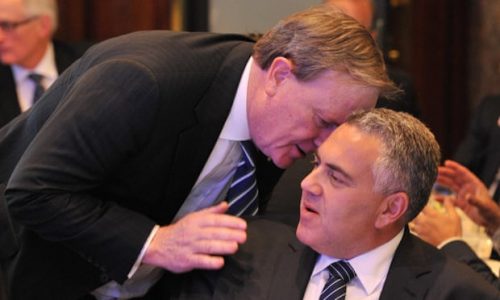The Coalition money shuffle

One of Joe Hockey’s first acts as Treasurer in 2013 was to gift the RBA $8.8 billion. The main reason for this was to make Labor’s deficit look bigger. As a side bonus, it allowed the RBA to invest in the forex market, banking on the Australian dollar losing value as the mining boom subsided.
And that is exactly what happened allowing the government to draw…wait for it…$8.8 billion in dividends over the last six years. That’s all very well (if we ignore how the Coalition screamed like stuck pigs when Labor took a one-off dividend of $500 million in 2013) except Hockey borrowed the $8.8 billion so we are still paying interest on it.
We have also paid a fortune in “fees for banking services” as investment banks have raked in hundreds of millions in trading fees.
Had Hockey not engaged in this political chicanery, we would be billions of dollars better off.
And then there are the six Future Funds which contained $198.8 billion as at June 30 this year.
The direct cost of managing these funds was over $1 billion for the last three years alone.
The DisabilityCare Australia Fund had $16.4 billion sitting in it, which must be aggravating to the many people still waiting to access services or those who have had their services reduced.
The Aboriginal and Torres Strait Islander Land and Sea Future Fund (ATSILS Fund) was established in February 2019 with a capital contribution of $2 billion transferred from the Aboriginal and Torres Strait Islander Land Account.
The purpose of the Indigenous Land and Sea Corporation, to whom the fund will make payments apparently at the discretion of the Minister if the investment mandate targets have been met, is to acquire and manage land, water and water-related rights so as to attain economic, environmental, social or cultural benefits. One wonders how much will actually be handed over for that purpose now that Peter Costello has his hands on it. I am sure the mining companies would prefer that money to be tied up rather than used.
In July, the government deposited another $7.8 billion into the Medical Research Future Fund. As we were still in deficit, this was a pretty amazing feat which must have come at the cost of other research cuts and/or interest costs for the borrowed money. It’s interesting how they can find a lazy $8 billion when they want to.
The Education Investment Fund, originally intended for new facilities in the higher education sector, had payments frozen in 2013 and it has been accumulating funds since. These have now been taken to create the government’s new $4 billion Emergency Response Fund.
Then, on 1 September 2019, the assets of the Building Australia Fund were transferred to the newly created Future Drought Fund.
The original Future Fund was established in 2006, funded in part from budget surpluses but mainly from the sale of Telstra. As at June 30, there was $162.6 billion sitting in it.
Kevin Rudd, as Opposition leader, suggested using $2.7 billion of it to invest in a National Broadband Network with profits being returned to the Future Fund. The Howard government screamed blue murder, claiming that Labor intended to “raid” the Future Fund for their own means. Gee, that has worked out well for us hasn’t it.
While legislation permits drawdowns from the Future Fund from 1 July 2020, the Government announced in the 2017-18 budget that it will refrain from making withdrawals until at least 2026-27.
What on earth is the point of sitting on that pile of money when only 20% of it is invested in Australia?
The ten year return has been 10.4% for the Future Fund which might sound good until you look at Infrastructure Australia’s High Priority Project list where every project has a cost benefit ratio of better than that.
We could be employing people in productivity enhancing infrastructure construction. We could be increasing primary healthcare and reducing hospital waiting times to save money and improve quality of life. We could be investing in research and education, both of which bring a far greater return than 10%.
But the Coalition are obsessed with accumulating cash and apparently have zero understanding of the value of actually using the money for the benefit of our economy and our citizens.
Like what we do at The AIMN?
You’ll like it even more knowing that your donation will help us to keep up the good fight.
Chuck in a few bucks and see just how far it goes!
Your contribution to help with the running costs of this site will be gratefully accepted.
You can donate through PayPal or credit card via the button below, or donate via bank transfer: BSB: 062500; A/c no: 10495969









